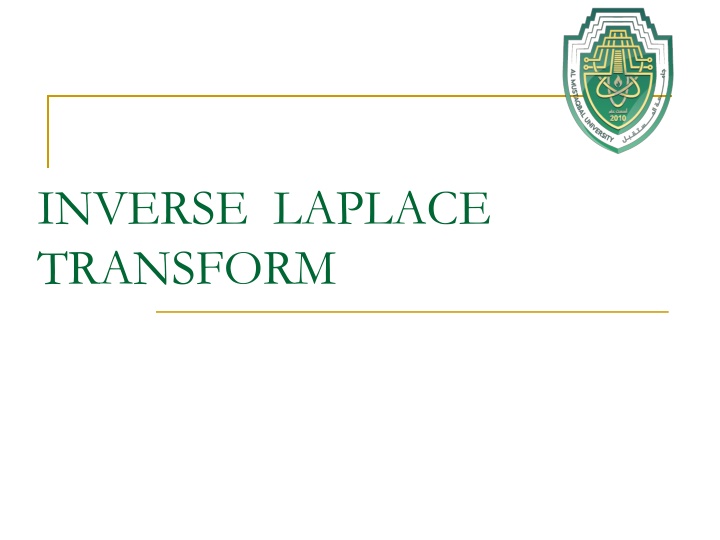
Laplace Transforms and Their Applications in Mathematics
Explore the concept of Laplace transforms, their role in transforming mathematical problems for easier solutions, and their applications in solving differential equations and other problems. Learn about the properties, common functions, and key techniques associated with Laplace transforms. Grasp the fundamentals of Laplace transformations and enhance your mathematical understanding efficiently.
Download Presentation

Please find below an Image/Link to download the presentation.
The content on the website is provided AS IS for your information and personal use only. It may not be sold, licensed, or shared on other websites without obtaining consent from the author. If you encounter any issues during the download, it is possible that the publisher has removed the file from their server.
You are allowed to download the files provided on this website for personal or commercial use, subject to the condition that they are used lawfully. All files are the property of their respective owners.
The content on the website is provided AS IS for your information and personal use only. It may not be sold, licensed, or shared on other websites without obtaining consent from the author.
E N D
Presentation Transcript
INVERSE LAPLACE TRANSFORM
Definition Transforms -- a mathematical conversion from one way of thinking to another to make a problem easier to solve problem in original way of thinking solution in original way of thinking solution in transform way of thinking inverse transform transform 2. Transforms
Laplace transformation time domain linear time domain solution differential equation Laplace transform inverse Laplace transform Laplace transformed equation algebra Laplace solution Laplace domain or complex frequency domain 4. Laplace transforms
Basic Tool For Continuous Time: Laplace Transform = = st L [ ( )] ( ) ( ) f t F s f t e dt 0 Convert time-domain functions and operations into frequency-domain f(t) F(s) (t R, s C) Linear differential equations (LDE) algebraic expression in Complex plane Graphical solution for key LDE characteristics Discrete systems use the analogous z-transform
The Complex Plane (review) Imaginary axis (j) = + u x jy y y = 1 tan u x r r x Real axis = + 2 2 | | | | u r u x y y = u (complex) conjugate x jy
Laplace Transforms of Common Functions Name f(t) 0 F(s) = 1 0 t = ( ) f t Impulse 1 0 t 1 ( = t ) 1 f Step s 1 s = ( ) f t t Ramp 2 1 = at ( ) f t e Exponential s a 1 + = ( ) sin( ) f t t Sine 2 2 s
Laplace Transform Properties = Addition/S caling [ ( ) ( )] ( ) ( ) L af t bf t aF s bF s 1 2 1 2 d = Differenti ation ( ) ( ) 0 ( ) L f t sF s f dt ( s ) 1 s F s = + Integratio n ( ) ( ) L f t dt f t dt = 0 t t = Convolutio n ) ( ) ( ) f (t ( d F s F s )f 1 2 1 2 0 + = Initial value theorem 0 ( ) lim s ( ) - f sF s = Final value theorem lim t ( ) lim s ( ) - f t sF s 0
Transforms (5 of 11) Most mathematical handbooks have tables of Laplace transforms 4. Laplace transforms
LAPLACE TRANSFORMS PARTIAL FRACTION EXPANSION
Definition Definition -- Partial fractions are several fractions whose sum equals a given fraction Purpose -- Working with transforms requires breaking complex fractions into simpler fractions to allow use of tables of transforms
Partial Fraction Expansions + 1 s s A B Expand into a term for each factor in the denominator. Recombine RHS = + ( ) 2 + ) 3 + + + ( 2 3 s s s ( ) + + s + + 1 s ( ) 3 2 s A s B s = ( ) 2 + ) 3 + ( ) 2 + ) 3 + ( ( s s Equate terms in s and constant terms. Solve. Each term is in a form so that inverse Laplace transforms can be applied. + B = +B = 1 3 2 1 A A + 1 s 1 2 + s = + ( ) 2 + ) 3 + + ( 2 3 s s s
Example of Solution of an ODE 2 d y dy ODE w/initial conditions + + = = = 6 8 2 ) 0 ( y ) 0 ( ' y 0 y 2 dt dt Apply Laplace transform to each term Solve for Y(s) + + = 2 ( ) 6 ( ) 8 ( ) 2 / s Y s s Y s Y s s 2 = ( ) Y s ( ) 2 + ) 4 + ( s s s Apply partial fraction expansion Apply inverse Laplace transform to each term s 1 1 + 1 = + + ( ) Y s + 4 2 ( ) 2 4 ( ) 4 s s 2 4 t t 1 e e = + ( ) y t 4 2 4
Different terms of 1st degree To separate a fraction into partial fractions when its denominator can be divided into different terms of first degree, assume an unknown numerator for each fraction Example -- (11x-1)/(X2 - 1) = A/(x+1) + B/(x-1) = [A(x-1) +B(x+1)]/[(x+1)(x-1))] A+B=11 -A+B=-1 A=6, B=5
Repeated terms of 1st degree (1 of 2) When the factors of the denominator are of the first degree but some are repeated, assume unknown numerators for each factor If a term is present twice, make the fractions the corresponding term and its second power If a term is present three times, make the fractions the term and its second and third powers 3. Partial fractions
Repeated terms of 1st degree (2 of 2) Example -- (x2+3x+4)/(x+1)3=A/(x+1) + B/(x+1)2 + C/(x+1)3 x2+3x+4 = A(x+1)2 + B(x+1) + C = Ax2 + (2A+B)x + (A+B+C) A=1 2A+B = 3 A+B+C = 4 A=1, B=1, C=2 3. Partial fractions
Different quadratic terms When there is a quadratic term, assume a numerator of the form Ax + B Example -- 1/[(x+1) (x2 + x + 2)] = A/(x+1) + (Bx +C)/ (x2 + x + 2) 1 = A (x2 + x + 2) + Bx(x+1) + C(x+1) 1 = (A+B) x2 + (A+B+C)x +(2A+C) A+B=0 A+B+C=0 2A+C=1 A=0.5, B=-0.5, C=0 3. Partial fractions
Repeated quadratic terms Example -- 1/[(x+1) (x2 + x + 2)2] = A/(x+1) + (Bx +C)/ (x2 + x + 2) + (Dx +E)/ (x2 + x + 2)2 1 = A(x2 + x + 2)2 + Bx(x+1) (x2 + x + 2) + C(x+1) (x2 + x + 2) + Dx(x+1) + E(x+1) A+B=0 2A+2B+C=0 5A+3B+2C+D=0 4A+2B+3C+D+E=0 4A+2C+E=1 A=0.25, B=-0.25, C=0, D=-0.5, E=0 3. Partial fractions
Apply Initial- and Final-Value Theorems to this Example 2 Laplace transform of the function. = ( ) Y s ( ) 2 + ) 4 + ( s s s ) 0 ( 2 1 Apply final-value theorem = = lim ( ) f t t 0 ( ) 2 + ) 4 + 0 ( ) 0 ( 4 Apply initial- value theorem 2 ( ) = = lim ( ) 0 f t 0 t ( ) 2 + ) 4 + ( ( )
LAPLACE TRANSFORMS SOLUTION PROCESS
Solution process (1 of 8) Any nonhomogeneous linear differential equation with constant coefficients can be solved with the following procedure, which reduces the solution to algebra 4. Laplace transforms
Solution process (2 of 8) Step 1: Put differential equation into standard form D2 y + 2D y + 2y = cos t y(0) = 1 D y(0) = 0
Solution process (3 of 8) Step 2: Take the Laplace transform of both sides L{D2 y} + L{2D y} + L{2y} = L{cos t}
Solution process (4 of 8) Step 3: Use table of transforms to express equation in s-domain L{D2 y} + L{2D y} + L{2y} = L{cos t} L{D2 y} = s2 Y(s) - sy(0) - D y(0) L{2D y} = 2[ s Y(s) - y(0)] L{2y} = 2 Y(s) L{cos t} = s/(s2 + 1) s2 Y(s) - s + 2s Y(s) - 2 + 2 Y(s) = s /(s2 + 1)
Solution process (5 of 8) Step 4: Solve for Y(s) s2 Y(s) - s + 2s Y(s) - 2 + 2 Y(s) = s/(s2 + 1) (s2 + 2s + 2) Y(s) = s/(s2 + 1) + s + 2 Y(s) = [s/(s2 + 1) + s + 2]/ (s2 + 2s + 2) = (s3 + 2 s2 + 2s + 2)/[(s2 + 1) (s2 + 2s + 2)]
Solution process (6 of 8) Step 5: Expand equation into format covered by table Y(s) = (s3 + 2 s2 + 2s + 2)/[(s2 + 1) (s2 + 2s + 2)] = (As + B)/ (s2 + 1) + (Cs + E)/ (s2 + 2s + 2) (A+C)s3 + (2A + B + E) s2 + (2A + 2B + C)s + (2B +E) 1 = A + C 2 = 2A + B + E 2 = 2A + 2B + C 2 = 2B + E A = 0.2, B = 0.4, C = 0.8, E = 1.2
Solution process (7 of 8) (0.2s + 0.4)/ (s2 + 1) = 0.2 s/ (s2 + 1) + 0.4 / (s2 + 1) (0.8s + 1.2)/ (s2 + 2s + 2) = 0.8 (s+1)/[(s+1)2 + 1] + 0.4/ [(s+1)2 + 1]
Solution process (8 of 8) Step 6: Use table to convert s-domain to time domain 0.2 s/ (s2 + 1) becomes 0.2 cos t 0.4 / (s2 + 1) becomes 0.4 sin t 0.8 (s+1)/[(s+1)2 + 1] becomes 0.8 e-t cos t 0.4/ [(s+1)2 + 1] becomes 0.4 e-t sin t y(t) = 0.2 cos t + 0.4 sin t + 0.8 e-t cos t + 0.4 e-t sin t
LAPLACE TRANSFORMS TRANSFER FUNCTIONS
Introduction Definition -- a transfer function is an expression that relates the output to the input in the s-domain y(t) r(t) differential equation y(s) r(s) transfer function 5. Transfer functions
Transfer Function Definition H(s) = Y(s) / X(s) Relates the output of a linear system (or component) to its input Describes how a linear system responds to an impulse All linear operations allowed Scaling, addition, multiplication X(s) H(s) Y(s)
Block Diagrams Pictorially expresses flows and relationships between elements in system Blocks may recursively be systems Rules Cascaded (non-loading) elements: convolution Summation and difference elements Can simplify
Typical block diagram reference input, R(s) plant inputs, U(s) error, E(s) output, Y(s) pre-filter G1(s) control Gc(s) plant Gp(s) post-filter G2(s) feedback H(s) feedback, H(s)Y(s) 5. Transfer functions
Example R L v(t) C v(t) = R I(t) + 1/C I(t) dt + L di(t)/dt V(s) = [R I(s) + 1/(C s) I(s) + s L I(s)] Note: Ignore initial conditions 5. Transfer functions
Block diagram and transfer function V(s) = (R + 1/(C s) + s L ) I(s) = (C L s2 + C R s + 1 )/(C s) I(s) I(s)/V(s) = C s / (C L s2 + C R s + 1 ) V(s) I(s) C s / (C L s2 + C R s + 1 ) 5. Transfer functions
Block diagram reduction rules Series Y U Y U G1 G2 G1 G2 Parallel Y + U G1 U Y + G1 + G2 G2 Feedback Y + U G1 U Y G1 /(1+G1 G2) - G2 5. Transfer functions
Rational Laplace Transforms ( ) A s = ( ) F s ( ) B s = + + + n ( ) ... A s a s a s a 1 0 n = + + + m ( ) ... B Poles s b s * b = s 0 b 1 0 m * = : (So, = ( *) ( *) ) s : B s F s = Zeroes (So, 0 ( *) ( *) ) 0 s A s F s Poles and zeroes complex are poles # = = Order of system m
First Order System ( ) Y s K K + = + + ( ) 1 1 R s K sT sT Reference (s ) R 1 (s ) (s ) U E (s ) Y K + 1 sT 1 (s ) B
First Order System Impulse response Exponential K 1 sT + Step response Step, exponential K K - / 1 + s s T Ramp response Ramp, step, exponential K KT KT - - / 1 + 2 s s s T No oscillations (as seen by poles)
Second Order System 2 ( ) Y s K = = Impulse response : N + + + 2 + 2 2 2 ( ) R s Js Bs K s s N N Oscillates if poles have non - imaginary zero part (ie, 2 4 ) 0 B JK B = = Damping ratio : where 2 B JK c B c K = Undamped natural frequency : N J
Second Order System: Parameters Interpreta 0 tion of damping ratio = = Undamped oscillatio n (Re 0, Im 0) 0 : Underdampe : 1 (Re d = Im) 0 1 Overdamped : (Re 0, Im 0) Interpreta tion of undamped natural frequency gives frequency the of oscillatio the n N
Transient Response Characteristics 2 1.75 = overshoot maximum M 1.5 p 1.25 1 0.75 0.5 0.25 0.5 rt 1 1.5 2 2.5 3 pt dt st Delay : until reach = 50% of steady state value t d Rise : time delay until first reach steady state value t r : Time at which peak value reached is t p stays = Settling : time within specified % of steady state t s
Transient Response Estimates the shape of the curve based on the foregoing points on the x and y axis Typically applied to the following inputs Impulse Step Ramp Quadratic (Parabola)
Effect of pole locations Oscillations (higher-freq) Im(s) Faster Decay (e-at) Faster Blowup (eat) Re(s)
Basic Control Actions: u(t) ( ) U s = = Proportion control al : ( ) ( ) u t K e t K p p ( ) E s t K ( ) U s 0 = = Integral control : i ( ) ( dt ) u t K e t i ( ) E s s ( ) d U s = = Differenti control al : ( ) ( ) u t K e t K s d d ( ) dt E s
Effect of Control Actions Proportional Action Adjustable gain (amplifier) Integral Action Eliminates bias (steady-state error) Can cause oscillations Derivative Action ( rate control ) Effective in transient periods Provides faster response (higher sensitivity) Never used alone
Basic Controllers Proportional control is often used by itself Integral and differential control are typically used in combination with at least proportional control eg, Proportional Integral (PI) controller: K ( ) 1 U s = = + = + I ( ) 1 G s K K p p ( ) E s s T s i
Summary of Basic Control Proportional control Multiply e(t) by a constant PI control Multiply e(t) and its integral by separate constants Avoids bias for step PD control Multiply e(t) and its derivative by separate constants Adjust more rapidly to changes PID control Multiply e(t), its derivative and its integral by separate constants Reduce bias and react quickly
Root-locus Analysis Based on characteristic eqn of closed-loop transfer function Plot location of roots of this eqn Same as poles of closed-loop transfer function Parameter (gain) varied from 0 to Multiple parameters are ok Vary one-by-one Plot a root contour (usually for 2-3 params) Quickly get approximate results Range of parameters that gives desired response
LAPLACE TRANSFORMS LAPLACE APPLICATIONS
Initial value In the initial value of f(t) as t approaches 0 is given by f(0 ) = Lim s F(s) s Example f(t) = e -t F(s) = 1/(s+1) f(0 ) = Lim s /(s+1) = 1 s 6. Laplace applications











